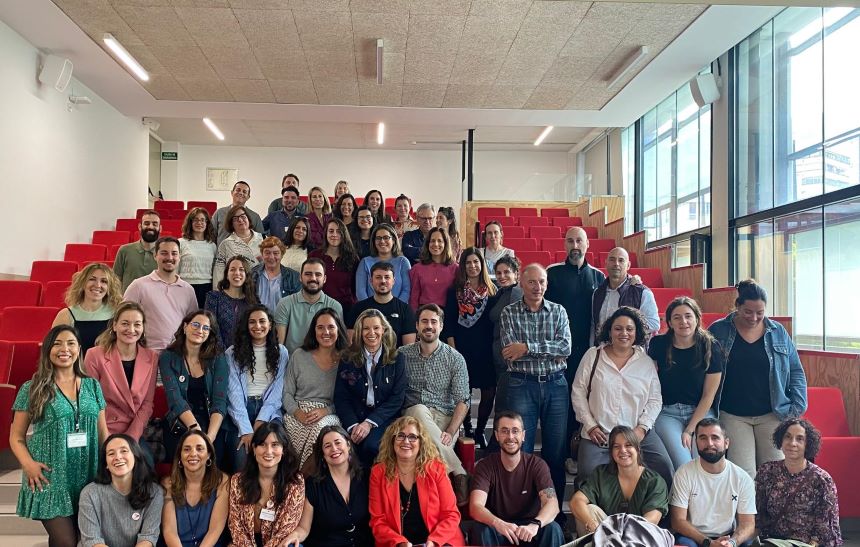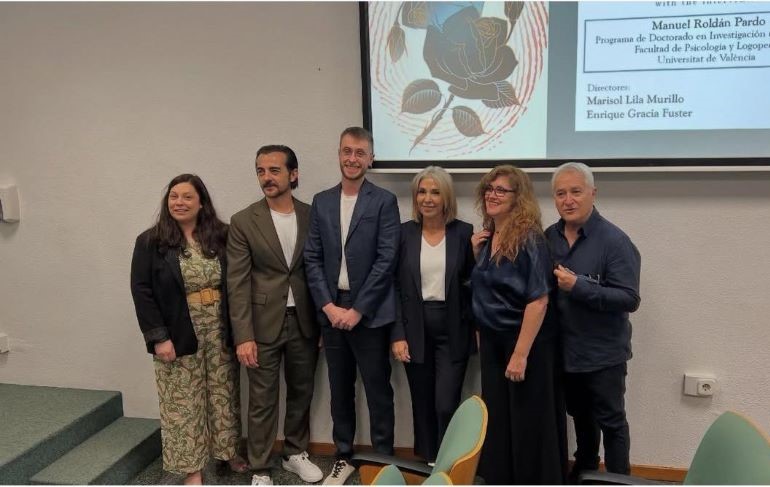The main aim of this line of research is the design, implementation, and evaluation of intervention programs and strategies for IPV perpetrators. To this end, VIO-STRATEGY developes assessment instruments, analizes variables that facilitate change, and design and rigorously evaluates (e.g., RCTs) intervention strategies that increase IPV perpetrators programs effectiveness.
Evidence-based intervention with intimate partner violence perpetrators
- Expósito-Álvarez, C., Roldán-Pardo, M., Vargas, V., Maeda, M., & Lila, M. (2025). The impact of trauma and substance use on emotion regulation and intimate partner violence perpetration: Implications for perpetrator programs. Behavioral Sciences, 15(2), 156. https://doi.org/10.3390/bs15020156
- Gheorghe, A., Comes-Fayos, J., Mesa-Gresa, P., Moreno, I. R., Lila, M., Romero-Martínez, Á., & Moya-Albiol, L. (2025). Traumatic brain injury effects on neuropsychological measures and recidivism in intimate partner violence against women perpetrators. Psychology of Violence. https://doi.org/10.1037/vio0000621
- Lila, M., Expósito-Álvarez, C., & Roldán-Pardo, M. (2025). Motivational strategies reduce recidivism and enhance treatment adherence in intimate partner violence perpetrators with substance use problems. Frontiers in Psychiatry, 16. https://doi.org/10.3389/fpsyt.2025.1538050
- Roldán-Pardo, M., Santirso, F. A., Tomás, J. M., Gracia, E., & Lila, M. (2025). Development and Validation of the Satisfaction with the Intervention for Intimate Partner Violence Perpetrators Scale (SIIPVS). Journal of Family Violence. https://doi.org/10.1007/s10896-025-00804-5
- Arrojo, S., Lila, M. y Conchell, R. (2024). Detección y prevención de la violencia de género con adolescentes. En F. Tortosa y F. Legaz (Dir.). Psicología jurídica y forense del menor (pp.485-499). Aranzadi.
- Arrojo, S., Santirso, F. A., Lila, M., Gracia, E., & Conchell, R. (2024). Dating violence prevention programs for at-risk adolescents: A systematic review and meta-analysis. Aggression and Violent Behavior, 101893. https://doi.org/10.1016/j.avb.2023.101893
- Expósito-Álvarez, C., Gilchrist, G., Gracia, E., & Lila, M. (2024). Evaluating the role of goal setting in reducing dropout for men with and without substance use problems attending a court-mandated intimate partner violence perpetrator program. Victims & Offenders, 19(6), 1175-1207. https://doi.org/10.1080/15564886.2024.2322960
- Expósito-Álvarez, C., Roldán-Pardo, M., & Lila, M. (2024). Análisis de las estrategias motivacionales en los programas de intervención para agresores de pareja: el impacto de las metas de cambio. Revista Iberoamericana de Justicia Terapéutica, 8,1-13
- Expósito-Álvarez, C., Roldán-Pardo, M., Gilchrist, G., & Lila, M. (2024). Integrated motivational strategies for intimate partner violence perpetrators with substance use: A randomized controlled trial. Psychosocial Intervention, 33(3), 187-200.https://doi.org/10.5093/pi2024a13
- García-Senlle, M. y Lila, M. (2024). Factores de riesgo y de protección asociados a la violencia de género en adolescentes. En F. Tortosa y F. Legaz (Dir.). Psicología jurídica y forense del menor (pp. 469-483). Aranzadi.
- Roldán-Pardo, M., Lila, M., Santirso, F. A., & Gracia, E. (2024). Group-related variables in intervention programs for intimate partner violence perpetrators: A systematic review. Trauma Violence & Abuse, 25(4), 2752-2767. https://doi.org/10.1177/15248380241226655
- Romero-Martínez, Á., Beser, M., Cerdá-Alberich, L., Aparici, F., Martí-Bonmatí, L., Sarrate-Costa, C., Lila, M., & Moya-Albiol, L. (2024). The role of intimate partner violence perpetrators' resting state functional connectivity in treatment compliance and recidivism. Scientific Reports, 14(1), 2472. https://doi.org/10.1038/s41598-024-52443-3
- Romero-Martínez, Á., Beser-Robles, M., Cerdá-Alberich, L., Aparici, F., Martí-Bonmatí, L., Sarrate-Costa, C., Lila, M., & Moya-Albiol, L. (2024). Gray matter volume differences in intimate partner violence perpetrators and its role in explaining dropout and recidivism. Journal of Psychiatric Research, 179, 220-228. https://doi.org/10.1016/j.jpsychires.2024.09.019
- Expósito-Álvarez, C., Santirso, F. A., Gilchrist, G., Gracia, E., & Lila, M. (2023). Participants in court-mandated intervention programs for intimate partner violence perpetrators with substance use problems: A systematic review of specific risk factors. Psychosocial Intervention, 32(2), 89-108. https://doi.org/10.5093/pi2023a7
- Lila, M., & Gilchrist, G. (2023). Treatment resistant perpetrators of intimate partner violence: Research advances. Psychosocial Intervention, 32(2), 55 - 58. https://doi.org/10.5093/pi2023a10
- Roldán-Pardo, M., Santirso, F. A., Expósito-Álvarez, C., García-Senlle, M. L., Gracia, E., & Lila, M. (2023). Self-Determined goals of male participants attending an intervention program for intimate partner violence perpetrators: A thematic analysis. International Journal of Offender Therapy and Comparative Criminology, 67(13–14), 1383–1400. https://doi.org/10.1177/0306624X231170120
- Romero-Martínez, Á., Lila, M., Sarrate-Costa, C., Comes-Fayos, J., & Moya-Albiol, L. (2023). Neuropsychological performance, substance misuse, and recidivism in intimate partner violence perpetrators. Psychosocial Intervention, 32(2), 69-77. https://doi.org/10.5093/pi2022a7
- Romero-Martínez, Á., Lila, M., Sarrate-Costa, C., Comes-Fayos, J., & Moya-Albiol, L. (2023). The interaction between attention deficit hyperactivity disorder and neuropsychological deficits for explaining dropout and recidivism of intimate partner violence perpetrators. European Journal of Psychology Applied to Legal Context, 15(1), 33-42. https://doi.org/10.5093/ejpalc2023a4
- Romero‐Martínez, Á., Lila, M., Sarrate‐Costa, C., Comes‐Fayos, J., & Moya‐Albiol, L. (2023). Dropout and recidivism are partly explained by emotional decoding and perspective taking deficits of intimate partner violence perpetrators. Aggressive Behavior, 49(3), 222-235. https://doi.org/10.1002/ab.22064
- Villagrán, A. M., Santirso, F. A., Lila, M. & Gracia, E. (2023) Attitudes toward intimate partner violence against women in Latin America: A systematic review. Trauma, Violence, & Abuse, 25(3), 2065-2077. https://doi.org/10.1177/15248380231205825
- Martín-Fernández, M., Gracia, E., & Lila, M. (2022). Measuring perceived severity of intimate partner violence against women (IPVAW) among the general population and IPVAW offenders. Psychosocial Intervention, 31(2), 109-119. https://doi.org/10.5093/pi2022a8
- Romero-Martínez, Á., Santirso, F., Lila, M., Comes-Fayos, J., & Moya-Albiol, L. (2022). Cognitive flexibility and reaction time improvements after cognitive training designed for men perpetrators of intimate partner violence: Results of a pilot randomized controlled trial. Journal of Family Violence, 37(3), 461-473. https://doi.org/10.1007/s10896-021-00304-2
- Expósito-Álvarez, C., Lila, M., Gracia, E., & Martín-Fernández, M. (2021). Risk factors and treatment needs of batterer intervention program participants with substance abuse problems. The European Journal of Psychology Applied to Legal Context, 13(2), 87-97. https://doi.org/10.5093/ejpalc2021a9
- Romero-Martínez, A., Lila, M., Gracia, E., Martín-Fernández, M., & Moya-Albiol, L. (2021). Generally antisocial batterers with high neuropsychological deficits present lower treatment compliance and higher recidivism. Psychology of Violence 11(3), 318-328. https://doi.org/10.1037/vio0000296
- Romero-Martínez, Lila, M., & Moya-Albiol, L. (2021). Alexithymic traits are closely related to impulsivity and cognitive and empathic dysfunctions in intimate partner violence perpetrators: New targets for intervention. Applied Neuropsychology: Adult, 28(1), 71-79. https://doi.org/10.1080/23279095.2019.1594233
- Lila, M., Gracia, E., & Catalá-Miñana, A. (2020). More likely to dropout, but what if they don’t? Partner violence offenders with alcohol abuse problems completing batterer intervention programs. Journal of Interpersonal Violence 35(9-10), 1958–1981. https://doi.org/10.1177/0886260517699952
- Lila, M., Gracia, E., Romero-Martínez, A., & Santirso, F. A. (2020). Estrategias motivacionales en intervención con agresores de pareja: El plan motivacional individualizado. En A. Martín, F. Fariña y R. Arce (Eds.), Psicología jurídica y forense: investigación para la práctica profesional (pp. 289-302). Sociedad Española de Psicología Jurídica y Forense.
- Santirso, F. A., Gilchrist, G., Lila, M., & Gracia. E. (2020). Motivational strategies in interventions for intimate partner violence offenders: A systematic review and meta-analysis of randomized controlled trials. Psychosocial Intervention 29(3), 175-190. https://doi.org/10.5093/pi2020a13
- Santirso, F. A., Lila, M., & Gracia, E. (2020). Motivational strategies, working alliance, and protherapeutic behaviors in batterer intervention programs: A randomized controlled trial. European Journal of Psychology Applied to Legal Context 12(2), 77-84. https://doi.org/10.5093/ejpalc2020a7
- Vargas, V., Conchell, R., Expósito, C., & Lila, M. (2020). Differences between Latin American and Spanish men in a batterer intervention programme: Proximal and final outcomes. Anales de Psicología 36(3), 418-426. https://doi.org/10.6018/analesps.428831
- Lila, M., Martín-Fernández, M., Gracia, E., López-Ossorio, J. J., & González, J. L. (2019). Identifying key predictors of recidivism among offenders attending a batterer intervention program: A survival analysis. Psychosocial Intervention, 28(3), 157-167. https://doi.org/10.5093/pi2019a19
- Romero-Martínez, A., Lila, M. y Moya-Albiol, L. (2019). Improving empathy with motivational strategies in batterer intervention programmes: Results of a randomized controlled trial. British Journal of Clinical Psychology, 58, 125-139. https://doi.org/10.1111/bjc.12204
- Romero-Martínez, A., Lila, M., & Moya-Albiol, L. (2019). Long-term drug misuse increases the risk of cognitive dysfunctions in intimate partner violence perpetrators: Key intervention targets for reducing dropout and reoffending. International Journal of Environmental Research and Public Health, 16(20), 3792. https://doi.org/10.3390/ijerph16203792
- Romero-Martínez, A., Lila, M., & Moya-Albiol, L. (2019). The importance of considering alexithymia during initial stages of intimate partner violence interventions to design adjuvant treatments. International Journal of Environmental Research and Public Health, 16(19), 3695. https://doi.org/10.3390/ijerph16193695
- Romero-Martínez, Á., Lila, M., Gracia, E., & Moya-Albiol, L. (2019). Dropout from court-mandated intervention programs for intimate partner violence offenders: The relevance of alcohol misuse and cognitive impairments. International Journal of Environmental Research and Public Health, 16(13), 2402. https://doi.org/10.3390/ijerph16132402
- Lila, M. y Gracia, E. (2018). La intervención con el agresor, una prioridad en la prevención de la violencia de género. Viure en Salut (Generalitat Valenciana), 114, 5-16.
- Lila, M., Gracia, E., & Catalá-Miñana, A. (2018). Individualized motivational plans in batterer intervention programs: A randomized clinical trial. Journal of Consulting and Clinical Psychology, 86(4), 309-320. https://doi.org/10.1037/ccp0000291
- Santirso, F. A., Martín-Fernández, M., Lila, M., Gracia, E., & Terreros, E. (2018). Validation of the Working Alliance Inventory-Observer Short Version with male intimate partner violence offenders. International Journal of Clinical and Health Psychology, 18(2), 152-161. https://doi.org/10.1016/j.ijchp.2018.02.003
- Carbajosa, P., Catalá-Miñana, A., Lila, M., & Gracia, E. (2017). Differences in treatment adherence, program completion and recidivism among batterer subtypes. The European Journal of Psychology Applied to Legal Context, 9(2), 93-101. https://doi.org/10.1016/j.ejpal.2017.04.001
- Carbajosa, P., Catalá-Miñana, A., Lila, M., Gracia, E., & Boira, S. (2017). Responsive versus treatment-resistant perpetrators in batterer intervention programs: Personal characteristics and stages of change. Psychiatry, Psychology and Law, 24(6), 936-950. https://doi.org/10.1080/13218719.2017.1347933
- Lila, M. (2017). Los programas de intervención con hombres condenados por violencia de género como herramientas generadoras de seguridad para las víctimas: Obstáculos y soluciones. En L. M. Nunes, A. Sani, R. Estrada, F. Viana, S. Caridade y R. L. Maia (Eds.), Crime e segurança nascidades contemporáneas. (pp. 17-32). Frontera do Caos Editores.
- Romero-Martínez, A., Lila, M., & Moya-Albiol, L. (2017). The 2D:4D ratio as a predictor of the risk of recidivism after a court-mandated intervention program for intimate partner violence perpetrators. Journal of Forensic Sciences, 62(3), 705-709. https://doi.org/10.1111/1556-4029.13315
- Vargas, V., Lila, M., Catalá-Miñana, A., & Gracia, E. (2017). Spanish and latin-american immigrants intimate partner violence offenders: Is there a differential profile? Revista de Acción Psicológica, 14(2), 51-68. https://doi.org/10.5944/ap.14.2.20753
- Conchell, R., Lila, M., & Catalá-Miñana, A. (2016). Intervención con hombres penados por violencia contra la mujer en las relaciones de pareja: El Programa Contexto. Informació Psicològica, 111, 51-63. https://doi.org/10.14635/IPSIC.2016.111.2
- Lila, M., Conchell, R., & Catalá-Miñana, A. (2016). Los programas de intervención con maltratadores como medida alternativa: Una herramienta de prevención de la violencia de género. En M. A. Cañete (coords.). Algunas formas de violencia: mujer, conflicto y género (pp. 217-242). Prensas de la Universidad de Zaragoza.
- Lila, M., García, A., Pedrón-Rico, V. y Terreros (2016). Fase de Evaluación y Motivación para el cambio. En L. Negredo (coord.), Programa Encuentro. Programa de intervención frente a la violencia familiar en medidas alternativas. Vol. 1 (pp. 71-221). Ministerio del Interior.
- Lila, M., Gracia, E., Catalá-Miñana, A., & Santirso, F. A. (2016). El consumo abusivo de alcohol en inmigrantes latinoamericanos que participan en programas de intervención para maltratadores: Importancia de la adherencia al tratamiento. Universitas Psychologica, 15(4). https://doi.org/10.11144/Javeriana.upsy15-4.caai
- Romero-Martínez, A., Lila, M., Martínez, M., Pedrón-Rico, V., & Moya-Albiol, L. (2016). Improvements in empathy and cognitive flexibility after court-mandated intervention program in intimate partner violence perpetrators: The role of alcohol abuse. International Journal of Emergency Mental Health and Human Resilience, 13, 394-407. https://doi.org/10.3390/ijerph13040394
- Lila, M., & García, A. (2015). Los programas de intervención con maltratadores como estrategia de prevención de la delincuencia de género. En E. Orts (Dir.), Derecho penal de la peligrosidad y prevención de la reincidencia (pp. 477-510). Tirant lo Blanch.
- Lila, M., García, A., Pedrón-Rico, V. y Terreros (2015). Fase de Evaluación y Motivación para el cambio. En L. Negredo (coord.), Programa de intervención para agresores de violencia de género en medidas alternativas. PRIA-MA (pp. 34-159). Ministerio del Interior.
- Lila, M., García, A., Pedrón-Rico, V., & Terreros (2015). Fase de Evaluación y Motivación para el cambio. En L. Negredo (coord.), Fuera de la red. Programa de intervención frente a la delincuencia sexual con menores en la red (pp. 46-204). Ministerio del Interior.
- Romero-Martínez, A., Lila, M., & Moya-Albiol, L. (2015). Empathy impairments in antisocial and borderline intimate partner violence perpetrators: A key factor for recidivisms risk. Violence and Victims, 31(2), 347-360. https://doi.org/10.1891/0886-6708.VV-D-14-00149
- Vargas, V., Lila, M., & Catalá-Miñana, A. (2015). ¿Influyen las diferencias culturales en los resultados de los programas de intervención con maltratadores? Un estudio con agresores españoles y latinoamericanos. Psychosocial Intervention, 24, 41-47. https://doi.org/10.1016/j.psi.2015.03.001
- Boira, S., Carbajosa, P., & Lila, M. (2014). Principales retos en el tratamiento grupal de los hombres condenados por un delito de violencia de género. Clínica Contemporánea, 5, 3-5. http://dx.doi.org/10.5093/cc2014a1
- Lila, M. (2014). Programas de intervención con maltratadores en medio abierto: indicadores preliminares de eficacia del Programa Contexto. En M. Roig (Ed.), Medidas de prevención de la reincidencia en la violencia de género (pp. 143-164). Tirant lo Blanch.
- Lila, M., Oliver, A., Catalá-Miñana, A. y Conchell, R. (2014). Recidivism risk reduction assessment in batterer intervention programs: A key indicator for program efficacy evaluation. Psychosocial Intervention, 23, 217-223. https://doi.org/10.1016/j.psi.2014.11.001
- Lila, M., Oliver, A., Catalá-Miñana, A., Galiana, L., & Gracia, E. (2014). The intimate partner violence responsibility attribution scale (IPVRAS). European Journal of Psychology Applied to Legal Context, 6, 29-36. https://doi.org/10.5093/ejpalc2014a4
- Catalá-Miñana, A., Lila, M., Conchell, R., Romero-Martínez, A., & Moya-Albiol. (2013). ¿Se benefician de los programas de intervención que no tratan específicamente el consumo de alcohol los maltratadores con problemas de consumo abusivo? Psychosocial Intervention, 22, 135-143. http://dx.doi.org/10.5093/in2013a16
- Lila, M. (2013). La intervención con hombres condenados por violencia de pareja contra la mujer en España: Investigación y avances en intervención. Psychosocial Intervention, 22, 81-85. http://dx.doi.org/10.5093/in2013a10
- Lila, M., Oliver, A., Catalá, A., & Conchell, R. (2013). Indicadores de cambio en un programa de intervención con maltratadores. En F. Expósito, I. Valor-Segura, M. Vilariño y A. Palmer (Eds.), Psicología jurídica aplicada a los problemas sociales (pp. 113-120). Sociedad Española de Psicología Jurídica y Forense.
- Lila, M., Oliver, A., Galiana, L. y Gracia, E. (2013). Predicting success indicators of an intervention programme for convicted intimate-partner violence offenders: The Contexto Programme. European Journal of Psychology Applied to Legal Context, 5, 73-95. https://journals.copmadrid.org/ejpalc/archivos/articulo20180219093255.pdf
- Lila, M., Oliver, A., Galiana, L., & Gracia, E. (2013). Indicadores de éxito en un programa de intervención con maltratadores: El Programa Contexto. Infocop Online, http://www.infocop.es/view_article.asp?id=4471&cat=53
- Lila, M., Oliver, A., Lorenzo, M. V., & Catalá, A. (2013). Valoración del riesgo de reincidencia en violencia contra la mujer en las relaciones de pareja: Importancia del apoyo social. Revista de Psicología Social, 28, 225-236. https://doi.org/10.1174/021347413806196681
- Conchell, R., Lila, M., & Catalá-Miñana, A. (2012). Cambios psicosociales en un programa de intervención con hombres penados por violencia contra la mujer. Revista de Psicología, 21, 159-186. https://doi.org/10.5354/0719-0581.2012.25841
- Lila, M., Gracia, E. y Herrero, J. (2012). Asunción de responsabilidad en hombres maltratadores: Influencia de la autoestima, la personalidad narcisista y la personalidad antisocial. Revista Latinoamericana de Psicología, 44, 99-108. https://core.ac.uk/download/pdf/229321709.pdf
- Carbajosa, P., Lila, M., Negredo, L., & Pérez, M. (2011). El delito de violencia de género y los penados extranjeros. Ministerio del Interior.
- Lila, M., Gracia, E. y Herrero, J. (2011). Domestic violence against women: Exploring attributions of responsibility among male offenders. En E. Kourkoutas y F. Erkman (eds.), Interpersonal acceptance and rejection. Social, emocional and educational contexts. Brown Walker Press.
- García, A., Lorenzo, M. V., Lila, M., & Conchell, R. (2010). La entrevista motivacional en un programa de intervención con penados por violencia contra la mujer. En F. Expósito, M. C. Herrera, G. Buela, M. Novo y F. Fariña (Eds.), Psicología Jurídica. Ámbitos de aplicación (pp. 3-17). Xunta de Galicia.
- Lila, M. (2010). Investigación e intervención en violencia contra la mujer en las relaciones de pareja. Intervención Psicosocial, 19, 105-108. https://doi.org/10.5093/in2010v19n2a1
- Lila, M. García, A. y Lorenzo, M. V. (2010). Manual de Intervención para maltratadores. PUV.
- Lila, M. y Gracia, E. (2010). Acuerdos y desacuerdos ante la intervención con maltratadores: estado actual y retos futuros. En F. Expósito, M.C. Herrera, G. Buela, M. Novo y F. Fariña (Eds), Psicología Jurídica, Ámbitos de aplicación (pp. 3-18). Xunta de Galicia.
- Lila, M., Catalá, A., Conchell, R., García, A., Lorenzo, M. V., Pedrón, V. y Terreros, E. (2010). Una experiencia de investigación, formación e intervención con hombres penados por violencia contra la mujer en la Universidad de Valencia: Programa Contexto. Intervención Psicosocial, 19, 167-180. https://doi.org/10.5093/in2010v19n2a8
- Lila, M. (2009). Intervención con hombres penados por violencia contra la mujer. En F. Fariña, R. Arce y G. Buela-Casal (Dirs.), Violencia de género. Tratado psicológico y legal. Biblioteca Nueva.
- Lila, M., Herrero, J. y Gracia, E. (2008). Atribución de responsabilidad y minimización en hombres penados por violencia contra la mujer: Un instrumento de evaluación. En F. J. Rodríguez, C. Bringas, F. Fariña, R. Arce y A. Bernardo (Eds.), Psicología jurídica. Familia y victimología. Ediciones de la Universidad de Oviedo.
- Lila, M., Herrero, J. y Gracia, E. (2008). Evaluating attribution of responsibility and minimization by male batterers: Implications for batterer programs. The Open Criminology Journal, 1, 4-11. https://doi.org/10.2174/1874917800801010004











